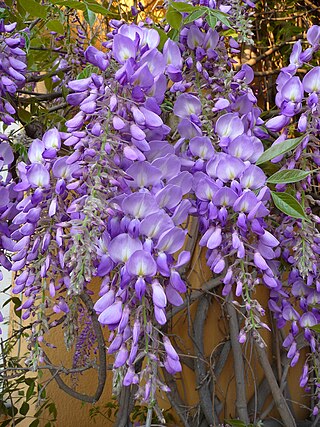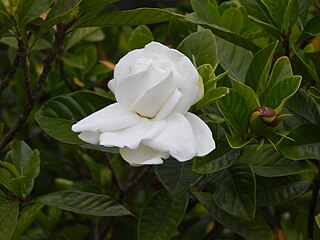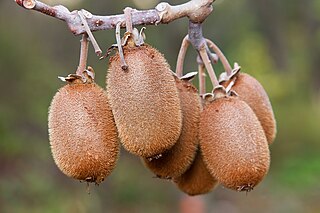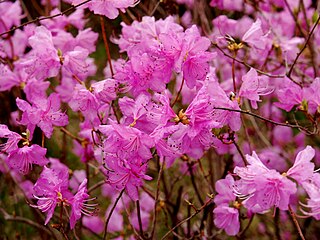
Kiwifruit or Chinese gooseberry is the edible berry of several species of woody vines in the genus Actinidia. The most common cultivar group of kiwifruit is oval, about the size of a large hen's egg: 5–8 centimetres in length and 4.5–5.5 cm in diameter. It has a thin, fuzzy, fibrous, tart but edible light brown skin and light green or golden flesh with rows of tiny, black, edible seeds. The fruit has a soft texture with a sweet and unique flavour.

The Actinidiaceae are a small family of flowering plants. The family has three genera and about 360 species and is a member of the order Ericales.

Actinidia is a genus of woody and, with a few exceptions, dioecious plants native to temperate eastern Asia, occurring throughout most of China, Taiwan, Korea, and Japan, and extending north to southern areas of Russian Far East and south into Indochina. The genus includes shrubs growing to 6 metres tall, and vigorous, strong-growing vines, growing up to 30 m (100 ft) in tree canopies. They mostly tolerate temperatures down to around −15 °C (5 °F), and some are much hardier.

Lapageria is a genus of flowering plants with only one known species, Lapageria rosea, commonly known as Chilean bellflower or copihue. Lapageria rosea is the national flower of Chile. It grows in forests in the southern part of Chile, being part of the Valdivian temperate rain forests flora.

Deutzia is a genus of about 60 species of flowering plants in the family Hydrangeaceae, native to eastern and central Asia, and Central America and also Europe. By far the highest species diversity is in China, where 50 species occur.

A daylily or day lily is a flowering plant in the genus Hemerocallis, a member of the family Asphodelaceae, subfamily Hemerocallidoideae. Despite the common name, it is not in fact a lily. Gardening enthusiasts and horticulturists have long bred daylily species for their attractive flowers. Thousands of cultivars have been registered by local and international Hemerocallis societies. Daylilies are perennial plants, whose name alludes to its flowers, which typically last about a day.

Lonicera japonica, known as Japanese honeysuckle and golden-and-silver honeysuckle, is a species of honeysuckle native to eastern Asia. It is often grown as an ornamental plant, but has become an invasive species in a number of countries. Japanese honeysuckle is used in traditional Chinese medicine.

Prunus serrulata or Japanese cherry is a species of cherry tree that grows naturally in Japan, China, and Korea, and it also refers to a cultivar produced from Prunus speciosa, a cherry tree endemic in Japan. Historically, the Japanese have developed many cultivars by selective breeding of cherry trees, which are produced by the complicated crossing of several wild species, and they are used for ornamental purposes all over the world. Of these, the cultivars produced by complex interspecific hybrids based on the Oshima cherry are also known as the Cerasus Sato-zakura Group.

Wisteria sinensis, commonly known as the Chinese wisteria, is a species of flowering plant in the pea family, native to China, in the provinces of Guangxi, Guizhou, Hebei, Henan, Hubei, Shaanxi, and Yunnan. Growing 20–30 m (66–98 ft) tall, it is a deciduous vine. It is widely cultivated in temperate regions for its twisting stems and masses of scented flowers in hanging racemes, in spring.

Rheum palmatum is a species of flowering plant in the knotweed family Polygonaceae. It is commonly called Chinese rhubarb, ornamental rhubarb, Turkey rhubarb or East Indian rhubarb.

Actinidia arguta, the hardy kiwi, is a perennial vine native to Japan, Korea, Northern China, and the Russian Far East. It produces a small kiwifruit without the hair-like fiber covering the outside, unlike most other species of the genus.

Actinidia deliciosa, the fuzzy kiwifruit, is a fruiting vine native to Southern China. Other species of Actinidia are also found in China and range east to Japan and north into southern areas of Russian Far East. This species grows naturally at altitudes between 600 and 2,000 m.

Euonymus fortunei, the spindle, Fortune's spindle, winter creeper or wintercreeper, is a species of flowering plant in the family Celastraceae, native to east Asia, including China, Korea, the Philippines and Japan. It is named after the Scottish botanist and plant explorer Robert Fortune. E. fortunei is highly invasive and damaging in the United States, causing the death of trees and forest in urban areas.

Gardenia jasminoides, commonly known as gardenia and cape jasmine, is an evergreen flowering plant in the coffee family Rubiaceae. It is native to parts of South-East Asia. Wild plants range from 30 centimetres to 3 metres in height. They have a rounded habit with very dense branches with opposite leaves that are lanceolate-oblong, leathery or gathered in groups on the same node and by a dark green, shiny and slightly waxy surface and prominent veins.

Saxifraga stolonifera is a perennial flowering plant known by several common names, including creeping saxifrage, strawberry saxifrage, creeping rockfoil, Aaron's beard, mother of thousands, roving sailor, and strawberry begonia or strawberry geranium.

Actinidia chinensis(Planch.), known commercially as the golden kiwifruit, is a fruiting vine, native to China. It is one of some 40 related species of the genus Actinidia, and closely related to Actinidia deliciosa, which is the source of the most common commercial kiwifruit. Fruit colour may vary from green to lime green or gold, depending on breeding.

Viburnum plicatum is a species of flowering plant in the family Adoxaceae, native to mainland China, Korea, Japan, and Taiwan. The Latin specific epithet plicatum means “pleated”, referring to the texture of the leaves.
Hardy kiwi is the name of a fruit product and common name of several species of the genus Actinidia:

Campanula punctata, the spotted bellflower, is a species of flowering plant in the bellflower family Campanulaceae. This ornamental herbaceous perennial is native to Japan, Korea, China and Siberia, and is widely cultivated for its attractive bell-shaped flowers.

Rhododendron mucronulatum, the Korean rhododendron or Korean rosebay, is a rhododendron species native to Korea, Mongolia, Russia, and parts of northern China. It is a deciduous shrub that grows to 1–2 m (3.3–6.6 ft) in height, with elliptic or elliptic-lanceolate leaves, 3–7 cm long by 1–3.5 cm wide. The reddish-purple flowers appear in late winter or early spring, often on the bare branches before the foliage unfurls. It inhabits forested regions at 1,600–2,300 m (5,200–7,500 ft).






















